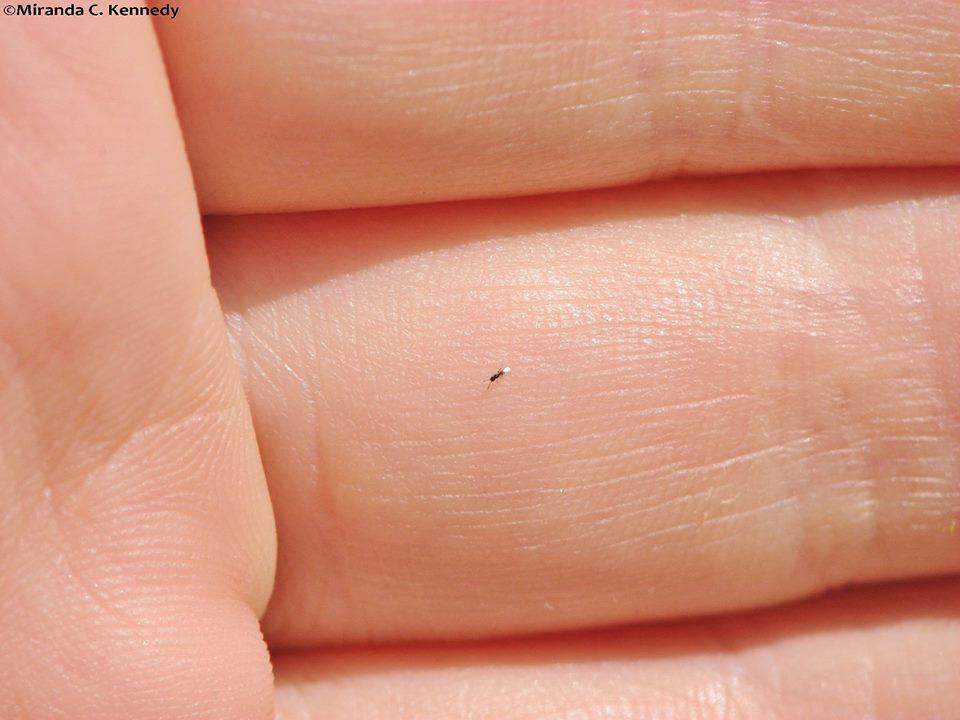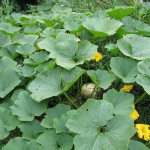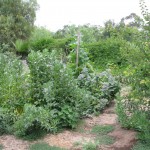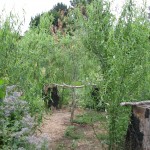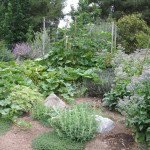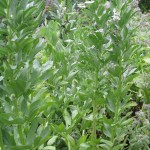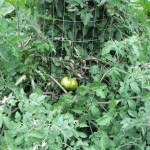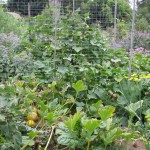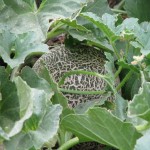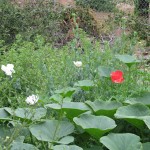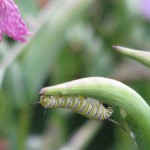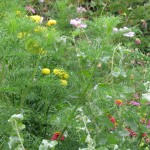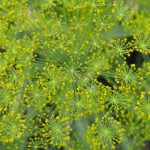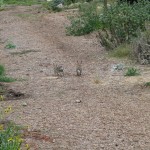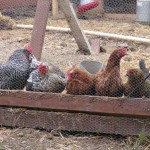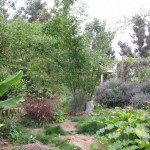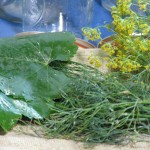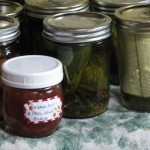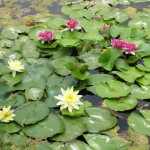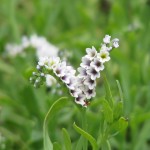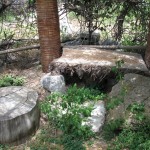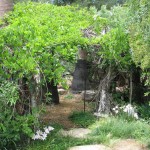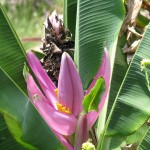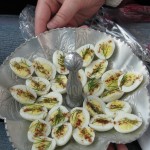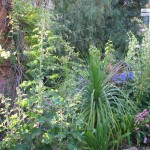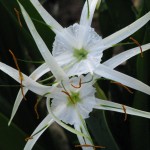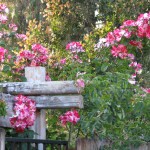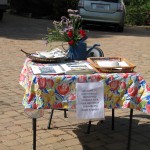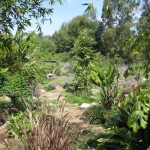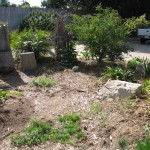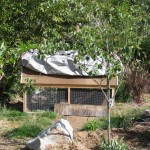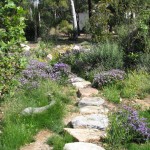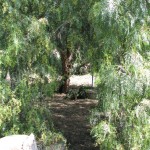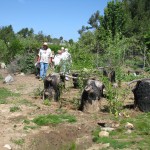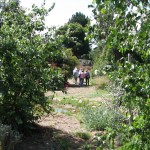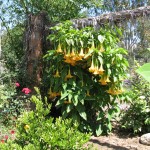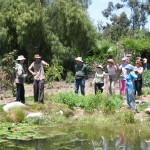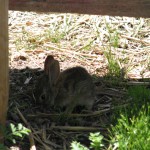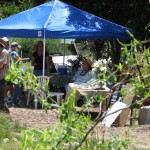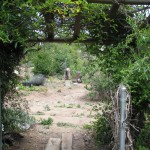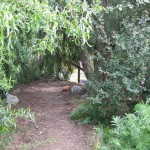- Animals, Bees, Birding, Gardening adventures, Other Insects, Permaculture and Edible Forest Gardening Adventures, Ponds, Reptiles and Amphibians, Soil, Worms
Fall Morning
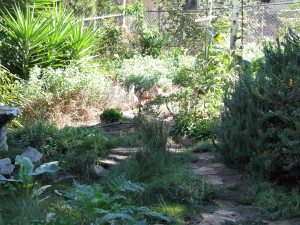
The birdwatching garden. I use the kitchen table as a work center, but spend a lot of time not working. That is because from the big dusty windowseat, through the spiderwebs that catch sunlight in the corners of the glass I watch a fairytale of animals. Song sparrows with their formal stripes and classy single black breast spot hop along the uneven flagstone walkway. The walkway, recently weeded, is again being compromised by sprouts. The small pond wears a heavy scarf of peppermint along its north side, and a mixture of fescues and waterplants around the south. A waterlily bravely floats pads on the still water after having been drastically thinned last month. A calla lily opens partially white, partially green.
Below the window in a dish of seed set low for ground feeders are house finches, the males’ proud red fading like the leaves of the Japanese maple behind the green bench. Lesser goldfinches skeletonize the leaves of sunflowers that have sprouted from birdseed; a nuthatch and a mountain chickadee take turns on the hanging suet feeder, both noisy and reminding me of pine forests. A pair of crows who have lived near this garden for years, but who have been about other business during the summer, are reunited on the telephone line. She grooms his feathers and he leans into her. I’ll have to put treats out for them, to keep on their good side. A Nutall’s woodpecker looks like a childhood toy by hopping straight up the big pine. I grin a welcome to a couple of white crowned sparrows, the forefront of the migratory flock. These spirited and chatty birds shuffle leaves onto my walkway every morning, and I quite happily sweep the leaves back for the next round. It is a ritual just between us. A young scrub jay swoops in with much show, seeing how big a reaction he can get from startling the smaller birds clustering at the feeders or taking warm dirtbaths. He lands on a small trellis and pecks out seeds from a sunflower I propped up after its yellow glory faded. Finches visit when he leaves and take their share of this high protein food.
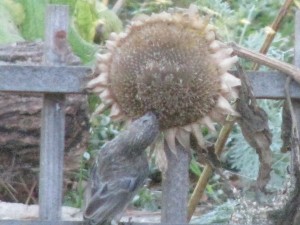
House finch nabbing sunflower seeds ( photo taken through a dirty window! Sorry!) The outside water is turned off; I should be on my knees in mud down by the chicken coop right now fixing a break in the pipe but I am held here by the autumnal light. Even in the morning it slants at a kinder angle, bringing out the gold in the leaves. Later when the water resumes the dripper on the bird bath will start and sparrows, finches, towhees and random visitors will sip drinks and take cleansing baths. One of my favorite sights is watching a group of finches taking turns in the bath, daring each other to stay longer and become wetter. Their splashing sends a cascade of drops into the sunlight. They give Finch Frolic its name. Now the only visitors are honeybees taking water to hydrate their honey. I emphathize with these bees. Only the older females do the pollen gathering, carrying heavy loads in their leg sacks back to the hive until they die in flight. A useful life, but a strenuous and unimaginative one.
Perhaps today there will also be a house sparrow, or a common yellowthroat or a disagreeable California towhee, what everyone knows as a ’round headed brown bird’. Or maybe the mockingbird will revisit the pyracantha berries, staking them out as his territory while finches steal them behind his back. I hear the wrentit’s bouncey-ball call, but as they can throw their voices I usually don’t spot them. Annas hummingbirds spend all their energy guarding the feeders, stopping to peer into the window to see if I’m a threat. My black cat Rosie O’Grady stares back, slowly hunching, mouth twitching with a soft kecking sound as if she could hunt through a window. I see that the hanging tray of grape jelly needs to be taken in and washed because the orioles have all migrated. Rosie is given up by the hummingbird and instead she watches cat TV as the birds shuffle in the Mexican primrose below the window.
I don’t see either of the bunnies this morning, Primrose or Clover. They live under the rosemary bush, and perhaps in the large pile of compost in the corner of the yard. I’ve watched them nibble the invasive Bermuda grass, and pull down stalks of weedy sow thistle and eat the flowers and seeds. They do no harm here, and are helping with the weeding; I love watching them lope around the pathways living in cautious peace.
Unseen by me by where I sit, mosquito fish, aquatic snails, dragonfly larvae, strange worms and small Pacific chorus frogs hang out in the pond and under the overhanging lips of flagstone I placed there just for them. Under the plants are Western fence lizards big and small awaiting warmth from the sun to heat up the rocks so they may climb the highest stone in their territory and posture while the heat quickens their blood. A mouse scurries between plants, capturing bits of birdseed scattered by the messy sparrows. The soil is good here, full of worms and microbes and fungus. Everything is full of life, if you only know how to look for it. You can smell it. You can feel it.
Now comes the spotted towhee, black headed with white patterns on his wings and reddish sides. Once called the rufous-sided towhee, he is bold and handsome, his call a long brash too-weeet. He sassily zig-zags down the narrow flagstone pathway looking for bugs.
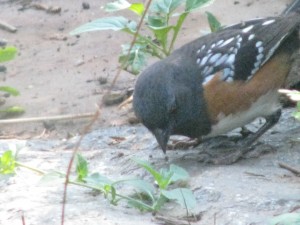
Spotted Towhee grubbing in his fancy clothes, so bright after a molt. I haven’t seen the rat family for a few days. The four youngsters invade the hanging feeders, tossing each other off and being juvenile delinquents. At night I hear the screech of a barn owl, which might be my answer.
The oxblood lilies – always a surprise during the dry and the heat of September, have almost all faded, but sprouts of paper white narcissus are beginning to break ground. They are Fall flowers here, usually done by Thanksgiving.
It is Fall. Finally. The world of my garden is tired and ready for a rest from the heat, the mating, the child rearing, the dryness, the search for diminishing food, the hiding so as not to become food. Although the days here are still in the high 80’s the evenings bring coolness and a much-needed dampness. Rain won’t come until November or later. But we wait for it, the animals, the plants and I. And time passes as I sit at the table and watch. I know of no better way to spend an autumn morning.
-
Jujube: a wonder tree

A handsome fruit. We mostly know the word jujube from having snacks as a kid in the movie theatre. Jujubes were once unchewable resinous candies of many flavors, and then were changed to something akin to gummy bears. Jujubes are a general term for a variety of candies in many countries. Oddly enough, and for reasons I know not, there is a tree called a jujube that bears wonderful fruit.

Jujube tree with fruit (a drupe, actually) ready to pick. Jujube trees (Ziziphus jujuba) have been cultivated in China for over four thousand years, and are gradually catching on in other countries. The first jujube fruit I ate was last year in a dried form. It was good, faintly reminiscent of a date. Now I have a tree that has just begun to bear fruit, and I am in love with it. The fruit is small, like very large olives. They begin green and then quickly turn to a reddish brown color, usually in blotches of color.

The fruit turns brown in patches, but can be eaten before completely dark. You can eat them fresh; in fact, I haven’t had them cooked yet. They are delightful. There is a center stone, such as in a date, but it holds two seeds.

Thin skin, crisp flesh like a green apple with a hint of date. The skin is thin and tender. The flesh is crisp and reminiscent of a green apple with hints of date. I love them. Many wait until the skin begins to wrinkle to eat them. You may pick the jujubes as they start turning color and they ripen quickly in the house without loss of flavor, or let them dry on the tree. Jujubes are high in vitamin C, and have been used medicinally in other countries, especially as a tea for sore throat. Best of all, so far the local birds ignore them, and there don’t seem to be any insect pests that love them.

Jujubes are a lovely reddish brown when ripe, and darken as they wrinkle. What makes the jujube a wonder tree is that it doesn’t seem to mind intense heat; in fact, it loves full sunshine and dry conditions. It also can survive a chill factor down to -28 degrees F! It doesn’t mind clay or alkaline soils, although good drainage and regular watering insures a good crop. They require little or no fertilization. There are many cultivars, the best being from China and more inferior ones from India and Japan. Many are thorny but some are virtually thornless. The trees can grow 30 feet high, have an attractive drooping appearance and are deciduous, the leaves yellowing before dropping. Suckers can appear several feet away from the trunk and can be controlled by mowing or pruning. You can read more about this remarkable tree here.
Why not try a jujube tree? They provide food, windbreak, mulch and have a very hard wood, and take just about any conditions. And the next time you go to a movie theatre you can bring your own jujubes… dried!
- Compost, Gardening adventures, Permaculture and Edible Forest Gardening Adventures, Rain Catching, Soil, Worms
Why Plant Natives?
The following article was written for and published in the summer 2012 Fallbrook Land Conservancy’s newsletter, the Conservation Chronicle (http://www.fallbrooklandconservancy.org/News/Chronicles/Summer2012/Summer2012.pdf, pg. 6). It was slightly edited and retitled for publication.
Why is planting native vegetation a good idea? We all know that native plants arranged in natural combinations and densities provide safety corridors for our native animals. San Diego’s plant communities have, like all established ecosystems, developed a symbiotic relationship with native and migratory fauna. Our plants leaf out, bloom and fruit when native animals and insects need the food, and provide appropriate nutrition that imported or invasive plants may not. Wildlife then disperses seed and pollen in methods that suit the plants, as well as providing the fertilizer for which the plants have adapted. Flora and fauna have set up symbiotic relationships to an extent where some species rely solely on a single other species for their existence. A balanced ecosystem is a dance between inhabitants who know each other’s needs and satisfy them for their own survival.
We plant natives in our yards because they are hard-wired for our soil and climate. They naturally conserve water and do not need fertilizer or insect control. They also can be beautiful. Planting native plants is good for our wallet, our resources and our health. But there is more to the equation. Living in every handful of good soil are billions of microscopic creatures and fungi collectively called microbes that make nutrients available to plant roots. The smell of fresh soil is a chemical released by these microbes called geosmin. Scientists now know that the microbes in undisturbed soils form a communication network between tree and plant roots. When a tree is attacked by insects, communication is sent out chemically by the tree’s roots and carried via this microbial network throughout the ecosystem, and other trees set up defense mechanisms to lessen their own damage.
Plants also communicate via scents not detectable by humans. Lima beans and corn planted downwind of brother plants which had been subjected to grasshopper attack lowered their sugar content to be less desirable. Such plants received 90% less insect damage than those planted upwind. California sagebrush (Artemisia californica) allows sibling plants to grow nearby because when attacked, it emits an airborne chemical to repel insects. The more sagebrush in the area, the better the protection as other sages respond in kind. Some plants when attacked will release a chemical that attracts the predatory insect which will feed upon the bug that is attacking the plant.
Thus plants communicate via airborne chemicals and through their roots via the microbial network. They call for help, they send out alarms and insect invitations and what’s more, they respond to each other. The why of planting natives is therefore also this: It is important to plant natives because they all speak the same language. Plants introduced to an area by humans are like strangers in a strange land. They cannot communicate well with other plants. They don’t know which bugs are bad until it’s too late. They have no one to call for help; the pheromones they emit are for beneficial bugs that live far away. Their seeds cannot supply the proper nutrition for the wildlife, and the wildlife may not be able to supply the plant with what it needs to keep healthy. They struggle to succeed in our soils and become stressed and sickly. We pour fertilizer and pesticides on them to help them survive, which kills the microbes that create good soil. Also, without the natural checks and balances found at the plant’s native ecosystem it may well become invasive and rob space, water and nutrition from our natives. The weeds you see in reclaimed properties are mostly non-native. Foxtails and wild radish do not belong here. Hike in some of the preserves which have not been previously farmed. There you’ll see the real native wildflowers, such as California peony, rattlesnake weed, tidy tips and Blue-Eyed Mary, living in harsh decomposed granite soils on little water, in relationships with the other chaparral surrounding them. You’ll understand a little more about how plants form guilds to support each other, and create that wholesome rightness that we feel when we walk in undisturbed nature. Recreating those guilds in your garden, adapted to provide human food, medicine and building materials, is called Permaculture.
- Gardening adventures, Heirloom Plants, Permaculture and Edible Forest Gardening Adventures, Vegetables, Vegetarian
Fun Vegetables

A small green zebra, not quite ripe In a past post I related how my mother had witnessed a woman staring hands-on-hips at the produce selection in a grocery store and exclaiming, “I wish they’d come up with some new vegetables!” How true is that? How many ways can you cook the limited offerings in your average supermarket produce section without going out of your mind? That’s where a trip to an ethnic grocery store can be a life-saver. Or, plant some fun new varieties in your garden.
Thanks to Baker Creek Heirloom (Organic) Seeds and their fantastic catalog, I was spoiled for choice. I also buy a lot from Botanical Interests , an organic seed company which has packets for sale in stores such as my neighborhood Joe’s Hardware. Their wildflower seed mixtures are highlights of my garden and attract birds, butterflies and other insects. Here are some newbies I tried this year, and the keepers:
Zucchino Rampicante : an heirloom zucchini that grows on a vine. This squash grows curled or straight on long vines that need support. The fresh squash can be used like zucchini, but are firmer and have a mild butternut flavor that goes well with everything. I am completely in love with the taste of these.
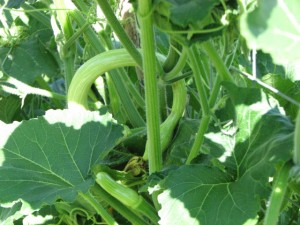
Some zucchinos are straight, some follow their own tune PLUS: if you leave the squash on the vine, it grows huge and unlike those monsterous zucchini clubs that are practically inedible and unwanted, zucchino then hardens and you can store it and use it as a winter squash! How marvelous and unwasteful is that! Zucchini without the pressure. No more alienating your neighbors and friends with excess squash.
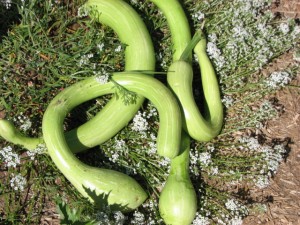
Zucchino shapes are marvelous Green Zebra Tomato :a large, lime-green striped tomato that develops a slight yellowish tinge between the stripes when ripe. These gorgeous tomatoes are rich and slightly tart, but without heavy acid. Marvelous on a open-faced sandwich or in a caprese salad to show off the color inside.
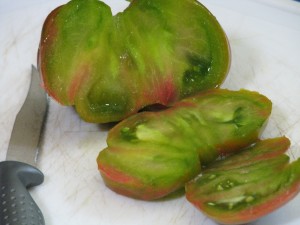
Green Zebra: beautiful inside Thai #2 Red Seeded Long Bean: The seeds were given to me by the woman who introduced me to Baker Creek Seeds, and who built my chicken and quail coops. I planted the seeds by stakes that turned out to be too short for the vines.
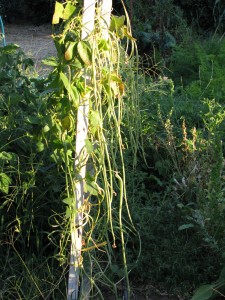
Long beans growing very long. However, these beautiful flowers eventually came, followed by spectacularly long thin green beans two feet long! One bean per person! (Just about, anyway). They are good stir-fried. I haven’t tried to tempura one yet, but its tempting.

Six long beans slice up to a serving for two! Mortgage Lifter Tomato : Now THESE are the ultimate sandwich tomato. These heavy pink-red fruits have mostly meaty insides and have an incredible savory flavor. I have found my favorite red tomato. Beefstake has nothing on this baby. It also has a cool name.
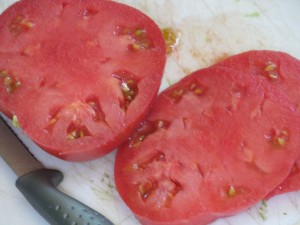
Mortgage Lifter is very meaty and savory 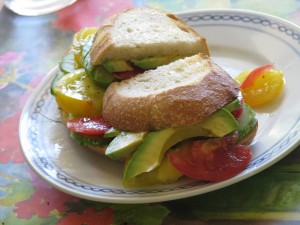
Rice Blue Bonnet: the jury is still out on this one. This is a dry-land rice. I didn’t thin it when I should have, so it is growing in clumps and hasn’t progressed beyond the thin leaves. My fault. It is growing and would probably be successful if I handle it right.
Basil Custom Blend HEIRLOOM Seeds : I planted a row and have regular and purple basil, lime basil, and cinnamon basil (one of my favorite scents). Today I used the regular and purple chopped over an open-faced tomato sandwich, and my daughter added leaves from the other two to a fruit salad.
Sesame, Light Seeded : Beautifully flowered plants with seed pods full of sesame seeds! How great is that?
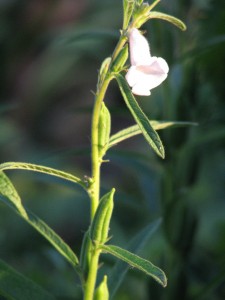
Sesame pods. Broad Windsor Fava Bean : I planted a lot of legumes to help build the soil (they set nitrogen), and tried fava beans this year. They grow like crazy, take a lot of neglect, and produce a fantastic protein source in the form of a tasty bean. They are a little trouble to shell, but well worth it. I wrote about favas here.
Blue Potatoes: These I started several years ago from an organic blue potato I bought at a grocery store. Since there are usually some small tubers left in the soil, I have volunteers sprouting every year. These blue potatoes – whatever their true variety is – are a lovely purplish blue outside, with a lovely purple center as well. They aren’t starchy, but are best used like red potatoes. Very fun.
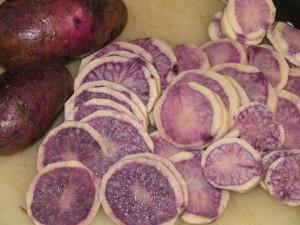
Peeled purple potatoes - Animals, Chickens, Gardening adventures, Heirloom Plants, Herbs, Other Insects, Permaculture and Edible Forest Gardening Adventures, Photos, Ponds, Quail, Vegetables
What’s Happening in the July Garden
A banana squash stealthily growing huge An apricot tree with fava beans, squash, herbs, artichokes, and tomatoes The withy hide growing beautifully Kabocha and delicata squash on the ground, zucchino rampicante on the trellis, Christmas beans, favas, Swiss chard and medicinal plants around a small avocado tree Favas: great for the soil, great for the dinnerplate Heirloom tomatoes. Why do they all come ripe at the same time? Sugar pumpkins are ripe already in the Mediterranean guild. Also figs, paste tomato, dill, fennel, thyme, pickling cucumbers and artichoke. Plant guilds of squash, beans, flowers, etc. are flourishing. Heirloom green melons hiding from the hot sun. By now the wild buckwheat has dried up, which starves the bees. But not here. Matilija and Flanders poppies over banana squash Monarchs are so plentiful this year that we have to take pains to avoid them. Wildflowers host an incredible diversity of insects Dill flowers looking like a spectacular firework In a balanced wildlife habitat, bunnys do little harm All five girls waiting for treats in the Fowl Fortress Pumpkins, bananas, bamboo and much more by fescue paths. Fresh grape leaves, dill and garlic from the garden for the pickles Hot weather? Must be canning season! Pickled cucumbers, zucchino and onions, and peach pit and peel jelly. Very large yellow waterlilies Native salt heliotrope by the big pond. Volunteer tomato in the shade of the Nest, by palm tree bench. Wisteria, grapes and zerpheranthum lilies around the Nest Blooming banana Quail eggs! Double heirloom hollyhock Egyptian lilies Fourth of July rose celebrating the holiday - Compost, Gardening adventures, Permaculture and Edible Forest Gardening Adventures, Soil, Vegan, Vegetables, Vegetarian
Fava Beans
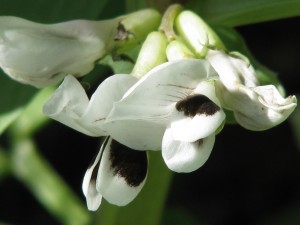
Fava flowers Have you ever eaten Italian, Greek or Middle Eastern food and found some enormous beans in it? Most likely those were fava beans. Commonly called broad beans or horse beans, these ancient beans are native to Africa and Asia, but can be found in cuisines worldwide.
There are a lot of reasons to grow them, even if you don’t eat the beans. First of all, they are nitrogen fixers, being a legume. However they don’t tendril like green beans do. The plant is a tall stalk (different varieties grow different heights) that sets beautiful flowers down the trunk. From these flowers grow some very weird-looking veggies. The pods look like clusters of swollen green fingers, I kid you not. The stalk can grow unsupported, but may topple over once the heavy pods are set.

Another reason to grow them is that they are hardy and can tolerate cold, and soils that are heavy in clay and salts (which pretty much describes my yard). Often broad beans are grown as a cover crop, then cut and allowed to decompose on the soil surface while the roots release the nitrogen under the soil.
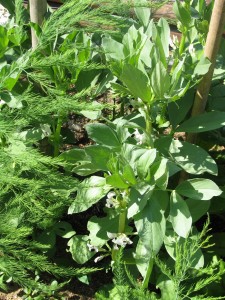
Then there is the reason that these very industrious plants produce an interesting protein-rich bean that enjoys notoriety worldwide (hence, easy to find different recipes for them!). The young leaves and flowers are edible as well.
To harvest favas, pull the swollen (but not too lumpy or they’ll be tough) pods from the stalks. Here comes the drawback: you have to shell the beans and it is a chore. Turn on a movie, pull up a bag of fava beans and an empty compost bucket, and go to. You may want to use a sharp knife to run down the seam, but I just used my fingernails. I watched the 1980’s TV show Cheers, which I never saw because I haven’t had television in about 17 years. Three episodes and I finished a big bag of favas!

When you’ve shelled the beans, you must blanch them for 3 minutes, then drop them in an ice bath. Rub the beans to remove a waxy coating. Then you can sautee them, mash them with potatoes, use them in fritters and soups, try an exotic Middle Eastern recipe with them. Fry them until they are crisp and serve salted as a snack. If you want to freeze them, then give the beans the blanch and ice water treatment, dry them and freeze them on a cookie sheet. Put them into a freezer bag. When you want to use them, then thaw, remove waxy shells and use. Some people don’t remove the coating, but its better if you do.
Fava beans have a nutty, slightly bitter and earthy flavor that becomes quite addictive. Two warnings, though. Some people, particularly those of Mediterranean decent, may be allergic. Also if you are taking anti-depressants, the beans are rich in tyramine and should be avoided by those taking monoamine oxidase (MAO) inhibitors – a type of medication used to treat severe depression.

Add fava beans to your garden and landscape. Just tuck the seed into the ground and stand back. Mine weren’t nibbled by rabbits or bothered by anything; however last year I grew six plants in a raised bed, and something opened all the pods and ate the beans. This year I have them planted all over the property to help build the soil, and the harvest appears to be all mine. I’m glad that Cheers ran so many seasons!

- Bees, Compost, Gardening adventures, Health, Heirloom Plants, Other Insects, Permaculture and Edible Forest Gardening Adventures, Soil, Vegetables
Integrated Gardening

Wildflowers, tasty borage, milkweed for the Monarch butterflies, and herbs. There are still those who prefer to have all their plants separate, each plant type confined to its own space. Vegetables should definitely not be allowed in the flower garden; herbs may be there only if more ornamental than useful, but don’t ever mix desert, country cottage or rose gardens together. That style of design is a matter of preference, and many gardens following those rules are very beautiful. They are usually also high maintenance, heavily fertilized, watered and sprayed, with poison set out for rodents.

A breadseed poppy is emerging in the sage. The blending of useful and ornamental plants is certainly not a new idea, and yet it isn’t often done. When it is, gardeners should find that the loss rate of plants to pests is quite low, and the yield of the vegetables is high.

Onions, native mallow, tarragon and sweet potatoes under a white fringe tree. Why is this? For one thing, planting mixed seeds which include ornamentals, herbs and vegetables masks the scent of the most yummy plants from its preditors. There aren’t rows of the same type of plant for the insects to find. Since different plants take up different nutrients from the soil, the soil isn’t depleted of one particular nutrient, so mixed plantings usually make for healthier and tastier plants.

My first tomatoes of the season, off of a volunteer along the pathway. Oh so yum! Wildflowers with cilantro, dill and basil not only are more successful and appealing to look at, but if let go to flower are excellent pollen sources for bees.

Young parsley, California poppy, cilantro and dill by rain lilies. Allowing desirable plants to reseed not only saves you money, but makes the new plant hardy and adapted for your particular garden.

Volunteers are welcome, such as this squash. Of course mixing plants is what an edible forest garden is all about, although the mixing isn’t random. Each plant serves a purpose. I use fava beans as a great edible nitrogen-fixer, along with other beans, peas, sweet peas, lupine, and nitrogen-fixing trees and shrubs. Artichokes grow quite large, and their leaves when cut and left on the ground make superb compost, as do the leaves of comfrey. Artichoke leaves keep growing back, and the plant will produce many very yummy artichokes. (Artichoke hint: wipe Vaseline around the stem below the bud to keep ants and earwigs from finding their way between the leaves.)

Artichoke and fava beans beneath an apricot tree. Melons and squash make an incredible ground cover during the hottest months. Their large leaves shade the soil surface and block evaporation. Remember that raccoons aren’t supposed to like going through squash vines, so plant them around your corn.

Green melon and corn by a variegated lemon (Sophie the dog by the car). Integrating your plants, especially when following the edible food forest guidelines, helps increase soil fertility (different plants remove different things from the soil). Mostly this is done by keeping the soil a more moist and inviting habitat for soil microbes and worms, but also by dropping their leaves which become mulch.

A guild: kabocha squash, heirloom squash and gourd (on wire) with onions interplanted to keep seedlings safe, along with something else that I don't remember planting, wildflowers, artichoke (under the milk carton for bunny protection), scented geraniums, lavender, borage, orgeano, sweet potatoes (not up yet), cowpeas, fava beans and Swiss chard by a small avocado tree. -
Edible Food Forest
This is a cheat blog, because I’m simply going to give you a link to a newspaper article. This is about land that has been dedicated to an edible food forest, which the public may enjoy. I hope it is the beginning of a new government trend to help feed the hungry. It also has a nice diagram about what a food forest may look like. Here it is: http://www.theepochtimes.com/n2/united-states/food-forest-takes-root-in-seattle-242907.html .
- Animals, Bees, Birding, Chickens, Compost, Gardening adventures, Health, Other Insects, Permaculture and Edible Forest Gardening Adventures, Photos, Ponds, Quail, Rain Catching, Reptiles and Amphibians, Soil
I Went to a Garden Party….

AAUW Garden Tour Saturday was the AAUW Garden Tour. What a glorious day. I expected about a hundred visitors, and made 120 handouts. Sometime in the early afternoon I guess they ran out, and I didn’t know about it for awhile. I made 25 more for the last two hours, and have five left. One of the docents said that some had been turned back in during the morning. Every couple probably took just one… wow, that’s a lot of people.
I’d been talking to the garden all week, asking the blooming plants to hold that thought for a few more days, and encouraging the nonblooming ones to get a move on. The plants did what I asked! There were so many flowers out Saturday, it was amazing. Heirloom roses, Gideon’s Trumpet, ranunculus, herbs, wildflowers, and waterlilies. The garden, apparently, also was also all for proof in advertising, as in standing behind the NWF Habitat sign on the front gate. So many kinds of butterflies and dragonflies were out for the first time this year that people remarked on it. In the afternoon, there were sightings of a king snake all over the property; I think it had to have been three kingsnakes. One was moved from the refreshment area, but he came back, and then as I was standing by the pond talking to some ladies one came past us. Another was sighted up in the driveway. Roger sighted a gopher snake. No one shrieked or complained; either these were hardy people, or the idea that this was a habitat yard made them keep calm. It also backed up my claims of letting snakes deal with gophers and rodents! One man spotted a baby bunny under the Withy Hide bench. By one o’clock, it was funny. It was as if a button had been pressed to turn the garden on, and all the features were working! What a glorious day.
Jacob (Aquascape Associates) and Roger (landscape architect) and I answered questions for most of the day; the last four visitors left at four. So many people asked questions about permaculture, soil, beekeeping, cob ovens and rain catchment that I know that I couldn’t answer everyone’s questions. Of course there were some who like a tidy, orderly garden, and that is fine. If everyone came away with some idea how to work with nature rather against it, to use chemicals less, to grow organic food, to repurpose, to compost their kitchen waste and weeds, then what a lot of small ripples of good will come of it.
Thank you to my dear friends who helped prepare the garden so that it looked stunning. And thank you to the snakes, butterflies, bees, dragonflies, birds, bunnies and who-knows-what-else that came out to perform for the visitors! And thank you to everyone who visited! No casualities; all good.
Here are some photos, although my camera doesn’t do the colors justice:
AAUW Garden Tour Welcome! Look at photos of how it was. Main entrance walkway Walkway into the Nest One of the many trails A palm sitting stump between guilds by the driveway A green melon under variegated lemon, with native grasses. Quail hut, with privacy boards up. Status and wildflowers across the stone walkway Cool spot under the upper pepper tree Roger and visitors by the Withy Hide Some of the first visitors of many Pickerel blooming in the little pond Gideon’s Trumpet keeping blooms and aroma until the tour Jacob teaching about natural ponds Baby bunny under the Withy Hide bench Roger answering questions View from the Bee Garden gate Cool spot under the pepper tree -
What I Punch Now
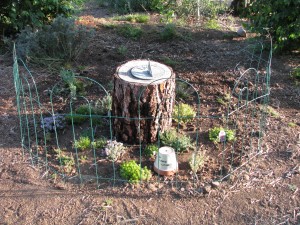
Sundial on the stump Its a Thyme Clock. So clever of me, I can hardly stand it. There is a sundial that I picked up at a thrift store, which sits on a stump. Around it are planted fourteen kinds of thyme! A Thyme Clock! I don’t have to punch a time clock at work… I can ‘punch’ (theoretically speaking that is) a Thyme Clock in my yard! (Or is the concept of a time clock too lost in history?). Ha!!!!
Sorry. Too much time in the sun (or should I say Thyme in the sun!) preparing for the Garden Tour tomorrow. I’m thinking its bedtime. Or bedthyme!!! No, it won’t stop anythyme soon. But it must, somethyme.
Sorry again.
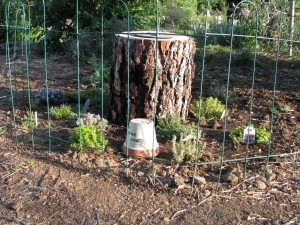
The Thyme Clock
